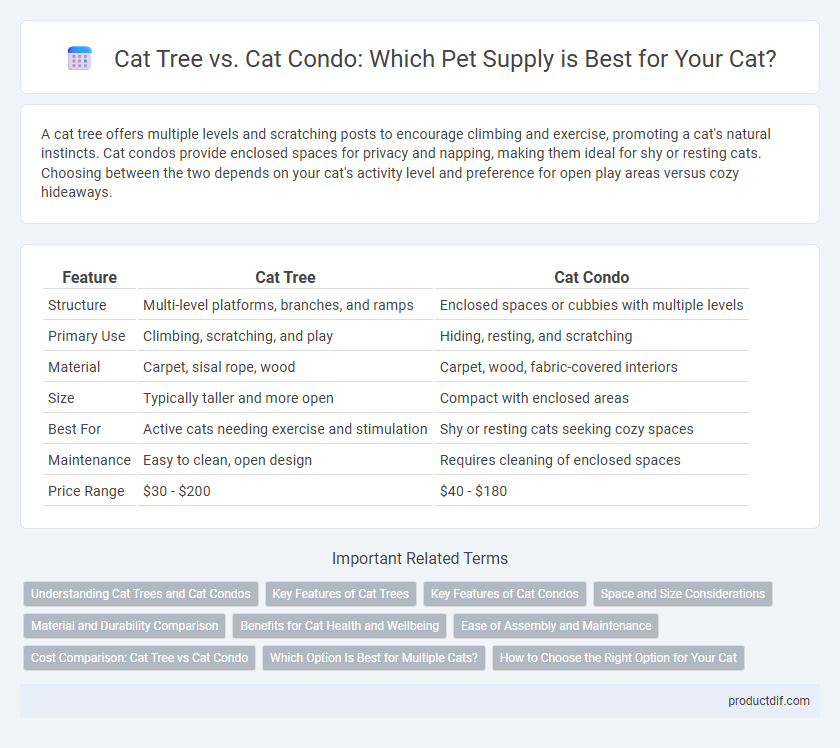A cat tree offers multiple levels and scratching posts to encourage climbing and exercise, promoting a cat's natural instincts. Cat condos provide enclosed spaces for privacy and napping, making them ideal for shy or resting cats. Choosing between the two depends on your cat's activity level and preference for open play areas versus cozy hideaways.
Table of Comparison
| Feature | Cat Tree | Cat Condo |
|---|---|---|
| Structure | Multi-level platforms, branches, and ramps | Enclosed spaces or cubbies with multiple levels |
| Primary Use | Climbing, scratching, and play | Hiding, resting, and scratching |
| Material | Carpet, sisal rope, wood | Carpet, wood, fabric-covered interiors |
| Size | Typically taller and more open | Compact with enclosed areas |
| Best For | Active cats needing exercise and stimulation | Shy or resting cats seeking cozy spaces |
| Maintenance | Easy to clean, open design | Requires cleaning of enclosed spaces |
| Price Range | $30 - $200 | $40 - $180 |
Understanding Cat Trees and Cat Condos
Cat trees feature multiple levels, platforms, and scratching posts designed to encourage climbing and active play, promoting feline fitness and mental stimulation. Cat condos offer enclosed spaces or cubbies that provide cozy, secure hiding spots ideal for rest and privacy, catering to cats' natural instincts for shelter. Both structures enhance a cat's environment, but selecting between a cat tree or condo depends on a pet's activity level and preference for open climbing versus secluded retreat.
Key Features of Cat Trees
Cat trees feature multi-level platforms, sisal-wrapped posts for scratching, and cozy perches designed to satisfy a cat's natural climbing and scratching instincts. These structures often incorporate interactive elements such as hanging toys and tunnels, promoting both physical activity and mental stimulation. Durable materials and sturdy construction support various cat sizes, ensuring long-lasting entertainment and comfort.
Key Features of Cat Condos
Cat condos offer multi-level platforms combined with enclosed spaces, providing cats with both climbing opportunities and secure resting spots. Featuring durable sisal-wrapped posts for scratching and removable cushions for easy cleaning, cat condos prioritize comfort and functionality. Their compact design fits urban living spaces while supporting natural feline behaviors like climbing and hiding.
Space and Size Considerations
Cat trees typically offer larger, multi-level platforms and sprawling designs ideal for spacious homes, while cat condos are more compact and enclosed, suitable for smaller areas. When choosing between the two, assess the available floor space and your cat's activity level to ensure optimal comfort and usability. Measurements of height, width, and base area directly impact stability and playability, making size a critical factor in selecting the right cat furniture.
Material and Durability Comparison
Cat trees often feature sturdy wood frames combined with carpet or sisal rope for scratching, offering superior durability and resistance to wear. Cat condos typically use engineered wood or MDF with fabric or faux fur coverings, which may wear out faster under heavy use. Materials such as solid wood and natural fibers enhance the longevity of cat trees compared to the lightweight construction of many cat condos.
Benefits for Cat Health and Wellbeing
Cat trees provide essential vertical space that supports feline exercise, mental stimulation, and scratching needs, promoting healthy joints and reducing stress. Cat condos offer cozy, enclosed areas that satisfy cats' natural instinct for secure resting spots, enhancing relaxation and reducing anxiety. Both structures encourage physical activity and environmental enrichment, crucial for maintaining optimal cat health and overall wellbeing.
Ease of Assembly and Maintenance
Cat trees typically feature a modular design with fewer parts, making ease of assembly straightforward and user-friendly, while cat condos often have enclosed spaces requiring more intricate setup. Maintenance of cat trees is simpler due to open structures that allow easy vacuuming and spot cleaning; cat condos, with tight corners and fabric interiors, may require more effort to keep clean and odor-free. Selecting between the two depends on balancing quick assembly and straightforward upkeep with the type of enrichment and privacy desired for the cat.
Cost Comparison: Cat Tree vs Cat Condo
Cat trees generally offer a more affordable option compared to cat condos, with prices ranging from $30 to $150 depending on size and materials. Cat condos, often featuring enclosed spaces and premium designs, typically cost between $100 and $300, reflecting their added comfort and aesthetic appeal. Investing in a cat tree provides budget-friendly climbing and scratching areas, while cat condos deliver enhanced privacy and style at a higher price point.
Which Option Is Best for Multiple Cats?
Cat condos offer multiple levels and enclosed spaces, making them ideal for multi-cat households by providing ample vertical territory and private hideouts that reduce territorial disputes. Cat trees generally feature open platforms and fewer compartments, which may lead to competition among cats but encourage social interaction and exercise. For multiple cats, cat condos often deliver better individualized space, minimizing stress and promoting harmony in a shared environment.
How to Choose the Right Option for Your Cat
When choosing between a cat tree and a cat condo, consider your cat's activity level and space preferences; cat trees offer vertical climbing and scratching opportunities, ideal for active cats, while cat condos provide enclosed, cozy spaces for cats that prefer privacy and resting spots. Evaluate the size and stability of the structure to ensure safety and comfort; tall, multi-level cat trees suit energetic cats, whereas compact cat condos work well in smaller living areas or for shy cats. Material quality, such as sisal-wrapped posts for scratching and soft plush cushions, also plays a key role in selecting the right option tailored to your cat's behavior and home environment.
Cat Tree vs Cat Condo Infographic

 productdif.com
productdif.com